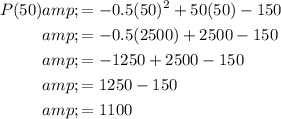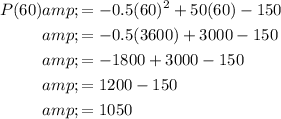Answer:

![\textsf{2)} \quad [0, 130]](https://img.qammunity.org/2024/formulas/mathematics/college/dmes3dyj5bkqrws67920k733wdpxhe0thk.png)


Explanation:
Question 1
The profit function P(x) is given by subtracting the cost function C(x) from the revenue function R(x):

Given functions:


Subtract C(x) from R(x):

Therefore, the profit function P(x) is:


Question 2
The domain of P(x) is the set of all valid values of x for which both the revenue function R(x) and the cost function C(x) are defined.
The variable x represents the number of items.
Given the maximum capacity of the company is 130 items, the domain of P(x) is restricted to:

Question 3
To find the profit for each case of producing 50 or 60 items, evaluate the profit function P(x) for these values of x.

Therefore, the profit when producing 50 items is $1,100.

Therefore, the profit when producing 60 items is $1,050.
The company should choose to produce 50 items, since this level of production results in higher profit.

Question 4
The simplified profit function is P(x) = -0.5x² + 50x - 150.
If we convert this into vertex form, we get:

Therefore, the vertex (maximum point) of the profit function is (50, 1100).
This means that the maximum profit is $1,100 when the company produces 50 items.
As the company produces more units beyond the optimal level (50 items), the profit starts to decline. Therefore, producing 10 more units beyond the optimal level leads to increased costs exceeding the additional revenue gained, resulting in lower overall profit.